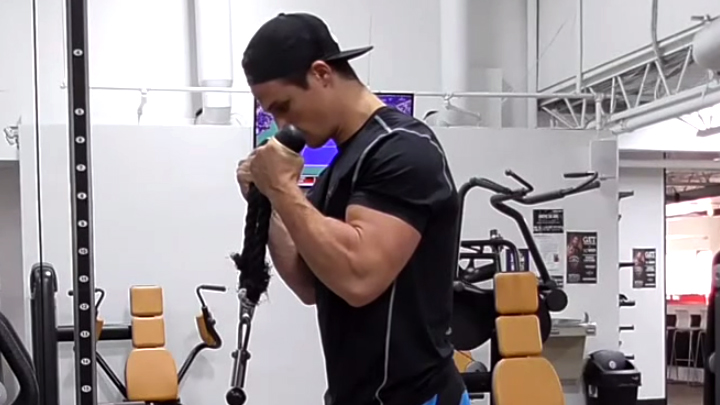It's human nature to gravitate towards the things we're good at and shy away from the things that make us feel weak. Consequently, our strengths get stronger while our weaknesses get weaker, or at least they appear to be weaker compared to our strengths. That's exactly what happens with weak bodyparts. Weak bodyparts are typically genetic issues that have been compounded by poor training, bad program design, or general neglect.
Maybe you were good at overhead pressing and had relatively strong shoulders when you started lifting but sucked at squatting and had puny legs. Chances are, you made pressing a priority in your program and half-assed legs or skipped them altogether. Trouble is, once you have a weak bodypart, a balanced program probably won't fix it. Imbalances require imbalanced programming with more emphasis placed on the weaknesses.
But simply bombing away at your weak points can quickly lead to joint problems and overuse injuries. Muscles can take a beating, but joints can't. Thus, the goal becomes striking a delicate balance of hammering the lagging muscle group without pissing off your joints.
Here's a simple way to do that regardless of what type of program or split you're following.
Most good coaches agree that heavy compound movements offer the best bang for your buck when it comes to building muscle and should thus form the framework of your program. That means presses, squats, deadlifts, rows, weighted chins, etc.
While those exercises are undoubtedly fantastic muscle builders and should be considered staples in your program, they're also tough on the joints. A small percentage of lucky guys with joints built to take a beating may be able to handle high frequency heavy barbell training without a problem. The majority of folks, though, will be better served by balancing heavy compound movements one or two times per week with more joint-friendly alternative exercises comprising the remainder of the work.
Say you're following an upper/lower split lifting four days a week and you're looking to bring up your quads. On your two lower body days, you'd do your regularly scheduled workouts consisting of heavy basic movements: squats, Dead-Squats, deadlifts, lunges, Romanian deadlifts (RDLs), etc.
Then on your upper body days, you'd add in a small amount of joint-friendly work to stimulate the quads, but not so much that it negatively affects your regular leg days and starts to bother your knees and lower back. If you're following a more traditional bodypart split where you hit each muscle once a week, you'd do your regular heavy leg day and then do your joint-friendly quad work on one to three of your other workouts.
These additional workouts shouldn't feel terribly hard, but you still want to elicit a training effect so they should be somewhat challenging. If you notice your regular heavy workouts starting to suffer or you experience joint pain and/or excessive muscular soreness, back off a little bit with the additional workouts.
When you start to increase the frequency, ease into it slowly by adding one additional day per week of joint-friendly work and gradually increase it to where you're hitting the lagging bodypart three to four times per week total, including the regularly scheduled heavy workouts. If you start to experience joint issues, back off and do one less day per week.
Here's a list of good exercises to choose for each major muscle group for the additional workouts. This list isn't exhaustive, but it's a good starting place. Feel free to employ different exercises as you see fit.
Chest
- Push-ups (regular, feet elevated, rings)
- Neutral-grip dumbbell presses
- Dumbbell flyes
This means you'd hit your chest once or twice per week with heavier bench press variations and then do 3-4 sets of 10-20 reps of one of the exercises above an additional one to three times per week.
Shoulders
- Dumbbell lateral raises
- Landmine lateral raises (my personal favorite)
- Cable lateral raises
- Rear delt reverse flyes
For long-term shoulder health, I recommend limiting overhead pressing to once a week and doing the remainder of your shoulder work with more shoulder-friendly lateral raise variations done in the 8-15 rep range for 2-4 sets on two or three extra days.
Back
- Inverted rows
- Bodyweight chin-ups (if proficient at chin-ups)*
- Chest supported rows
- Face pulls
- Scarecrows
- TRX bodyweight reverse flies
Here you'd do heavy deadlift, row, and chin-up variations once or twice per week (limit deadlifts to once a week) and then do the remainder of your upper back work selecting from the list above and doing 3-4 sets of 10-20 reps for your additional workouts.
* Bodyweight chin-ups can be a great choice if you're proficient at them and can do multiple sets of 8-10 reps without much of a struggle, but if chin-ups are hard for you, opt for different exercises for your bonus workouts.
Quads
- Reverse sled drags
- Goblet squats
- Light front squats *
- Bodyweight skater squats and single leg squats (if proficient) * *
Here you'd do you heavy squat, Dead-Squat, and lunge variations one to two times a week and then do some additional quad work from the list above another one to three times a week. Reverse sled drags are by far my first choice for the additional workouts if you have a sled.
* If you choose to do front squats, make sure to keep them very light for sets of 10-15 reps. It shouldn't be a struggle to complete the set. I like doing front squats on the same day I overhead press, using the same weight I'm using to press. This works well because the bar is already set up and it ensures that the weight is light.
* * Skater squats and single-leg squats are great choices for the additional workouts if you're proficient with them and can knock off multiple sets of 8-10 reps without much struggle.
Hamstrings
- Sliding leg curls
- Hamstring bodycurls
- Machine leg curls
- Glute-ham raises (if proficient) *
Here you'd do a heavy deadlift or RDL variation once a week and then do some work from the above list an additional one to three days a week, doing 3-4 sets of 8-15 reps.
* Glute-ham raises are an excellent choice for your additional hamstring workouts if you're good at them. If you're not they'll make you brutally sore and negatively affect your regularly scheduled lower body training sessions.
- You don't have to use the same exercise for all of your additional workouts; in fact it's best to switch it up. You want to maintain consistency with your heavy barbell work, but these additional workouts are a good time to use more variety to avoid overuse and boredom.
- Only focus on one bodypart at a time and stick with it for at least four to six weeks before returning to a more balanced program or changing your focus to something else.
If you feel like you have a number of weak body parts to address and feel compelled to try to work on them all at once, you're probably just weak in general and need to focus on getting stronger overall. Save weak point training for when you've built up a solid base of strength and muscle.




